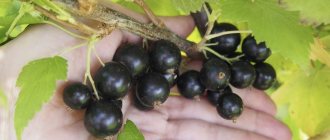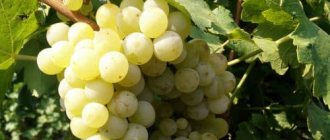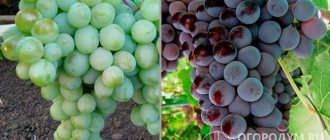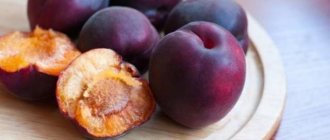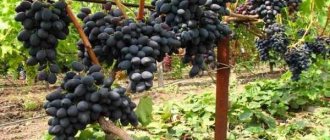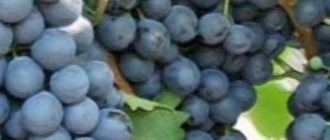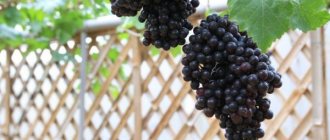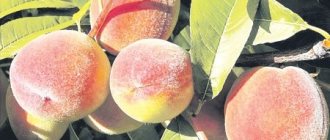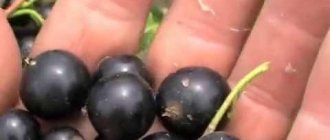Almost every person has tried grapes in his life. Some people grow such a plant on their property, others buy bunches of grapes at the market or in a store. The range of such plants is huge. Every consumer can find a type of grape that will combine the entire palette of tastes and will be to his liking. Its berries contain substances that benefit the human body. Fiber, vitamins A, B6, C, calcium, iron, selenium, phosphorus, etc. This article describes a grape variety called “black pearl”.
Benefits of black pearl grapes
There are jewels in the vineyards and one of them is Black Pearls. The wine variety is highly appreciated by winemakers around the world for its rich bouquet taste. The wine has a muscat taste and a strawberry-pink aftertaste.
Ripe bunches of Black Pearl grapes
The variety Black Pearl or Black Pearl was bred at the Y. Potapenko Research Institute. As a result of the work of scientific breeders, through complex crossing of hybrids August to Amursky and Centaur Magarachsky to Levokumsky, a wine-technical grape variety was obtained, which deservedly received the name of a jewel and was included in the State Register in 2005.
Application
Grapes are grown for use as raw materials. It is used to make wine. The wine product is obtained with high-quality characteristics, distinguished by a pleasant aroma and nutmeg aftertaste. Some winemakers add an additional 20% to the total volume of Augusta grapes to enhance the muscat bouquet and strawberry-pink aftertaste.
Young table wine, aged for one year, is assessed by experts at 7.6 units on a tasting scale of 10 points. Experts give the dessert drink, aged under special conditions for several years, a solid 9 for taste, aroma and lack of astringency.
The berries are also used for culinary dishes and canning.
The fruits can be frozen or eaten fresh. Young children especially like it. Raisins with distinctive taste are also made from berries. The most interesting thing is that no matter what manipulations are performed with the fruits, they do not lose their beneficial properties and the microelements and vitamins contained inside.
Features of black grapes
Description of the variety. Black grapes are cultivated mainly in areas with established industrial winemaking. Certain types of black culture are found in the wild. Black grapes are used to make wine, raisins and freeze them. The berry does not lose its beneficial qualities.
Description of the benefits of the fruit. Grape fruits have a positive effect on the circulatory system, preventing the development of thrombosis and strengthening the walls of blood vessels. People who regularly consume grapes rarely suffer from blood pressure or spikes in cholesterol levels. Black grapes are rich in vitamins that strengthen the immune system, preserve vision and have an antioxidant effect.
Plants need antioxidants to resist bacteria and fungi, and humans need them to protect against inflammation. When eating black grapes, the body receives beneficial microelements.
From the ancient Egyptian inhabitants came the knowledge that the extract and juice of grape fruits have a beneficial effect on the processes in the skin, giving the skin elasticity, firmness and even out the microrelief.
Black grapes of the Black Pearl variety
Pros and cons of the “black pearl”
Since this variety is mainly grown for making wine, we will evaluate it from this point of view.
Pros:
- Can be grown in temperate climates.
- High yield and endurance of grapes.
- Wine made from this variety retains all its taste and intense muscat aftertaste during long-term storage.
- In cooking, the fruits of the “pearl” are also very popular.
- High survival rate of a young plant or cuttings.
- Good compatibility with rootstocks.
- High assessment of the taste of wine from this variety.
The only downside is that when grown at home, the yield is not very high. Since this variety is mainly cultivated in areas where industrial winemaking is established. But for amateur cultivation, high yields are not needed.
Description of the Black Pearl
The variety is mid-early, harvesting begins in late summer - early autumn. Pearls have rugged five-fingered leaves, pubescent on the inside and bubbly on the outside. They are distinguished by the overlapping lobes of the petiole pit. The petiole is not much shorter than the central vein. The side cuts of the sheet are different in height, the edges are curved upward. Leafy tall shoots are distinguished by a bare edge.
Fruit clusters of grapes are medium (up to 300 grams), winged, elongated conical in shape, collected from medium-sized round berries of dark blue color. The grapes have a pronounced muscat aroma and a rich, harmonious taste. Distinguished by its juicy, fleshy and bright pulp, the berry produces uncolored juice. The sugar content of the fruit is 24% with an acidity of 7 g/dm3.
With proper care in compliance with agrotechnical principles, Black Pearl produces a harvest of 130 centners per hectare. The optimal load on the bush is 17-18 eyes. Vigorous bushes are formed on two shoulders and have a meter in height. Grape cuttings take root well.
The grapes are frost-resistant and can withstand temperatures as low as 26 degrees. However, it needs shelter for the winter. Winegrowers claim that in such frosts the variety is capable of maintaining a full harvest, and 28 degrees below zero leaves up to 25% of the harvest.
With all its advantages, the variety is not resistant to mildew, oidium and phylloxera.
Tasters rate the annual table wine from Black Pearl at 7.6 points, and the aged dessert wine at 9 points.
Black Pearl grape harvest
Variety resistance
The “black pearl” grapes showed good indicators of endurance to many factors:
- “Pearl” is not afraid of spring frosts. When flowering, the plant can withstand frosts down to -5 degrees, and there will be no consequences in fruiting.
- Good frost resistance of the vine. It tolerates frosts down to -26 degrees without much loss. But if frosts are above -26 degrees and without proper insulation of the plant, then you can suffer losses in yield of up to 78%.
- Grapes are not afraid of fungal diseases. But still, for prevention, the plant should be treated regularly.
- Grapes are less resistant to diseases such as bacteriosis and bacterial cancer.
- The variety is susceptible to attack by mites such as red mites, common mites and hornbeam mites. It is also afraid of phylloxera, but is rarely attacked by wild wasps.
Interesting fact
The famous winegrower Yu. A. Zotov lives in Tula, who grows the variety exclusively for winemaking. Zotov wine Black Pearl is distinguished by labor-intensive ancient technology. His wines participate in tastings and receive prizes. Making quality wine is not an easy task. Cooking technology alone is not enough; you still need to grow a decent berry. As the grape master notes: “To grow such grapes, patience and perseverance alone are not enough. You need to love grapes with all your heart!”
Reviews from winegrowers
“In my personal ranking among red varieties of technical grapes, Black Pearl occupies one of the first places. The expressive nutmeg flavor, in my opinion, is no worse than that of the Hamburg Misket, although the berries are smaller. But in terms of resistance to disease and freezing, Black Pearl will give it a big head start. At first, my bushes grew rather slowly, although all the seedlings took root, but later they showed their growth force.”
“I only have a few young Black Pearl bushes so far, so I don’t make wine from it, but I tried mixing the juice into the must with Pinot Noir. An additive in the amount of a tenth of the total volume already imparts a light muscat note to the finished wine in taste and bouquet. We mainly consume fresh berries - for a techie the taste is more than decent. They prefer to prepare them by drying; the raisins from Black Pearls are perfect.”
“In five years of cultivation, I have never seen mildew on the ChZh bushes. These grapes overwinter under film and do not freeze; I live in the Volgograd region. Friends grow quite successfully near Voronezh.”
Description of agrotechnical techniques for growing grapes
Grapes are a long-lasting crop, capable of bearing fruit for up to 22 years. Black berries begin to ripen in August.
How to choose a landing site
The variety will give a bountiful harvest if it is planted in a southern, southwestern or southeastern area and the vine is placed on supports, a trellis, or along the walls and slopes of roofs of buildings. Solar heat should flow freely to the planting site and excess moisture should not accumulate in the soil. A slight slope would be ideal.
Preparing the soil and planting vines
The soil for grapes is prepared fertile and fertilized with organic matter and nitrogen. Seedlings are planted in autumn or spring. The correct seedling has a white root when cut, a mature bright green shoot and strong eyes that do not fall off upon contact.
For better rooting in the ground, pre-planting preparation of seedlings is carried out. The upper node roots of the nodes are cut off, and the lower ones are docked a little and kept in water for up to 24 hours. The seedling is pruned into 3-5 eyes. Grapes should not be planted near trees or at the base of a slope.
Planting seedlings in the post office in spring
Spring planting
Description of spring planting of grapes. If there is a large amount of black soil or clay in the soil for planting seedlings, dig a trench 0.8 meters deep and wide, and if the soil is sandy, the depth should be at least a meter and prepare it in advance to give the soil time to settle. Deep burial will help protect the root system from freezing.
Article on the topic: White Zant - grapes
The bottom of the trench is covered with drainage made of crushed stone or expanded clay, the thickness of which reaches 15 cm, and a pipe for irrigation is fixed vertically. The next layer consists of chernozem containing potassium and phosphorus fertilizers. Ash can be used as a mineral fertilizer. This alternation of soils is carried out twice and is always completed with fertile soil and spilled with a large amount of water. The prepared trench is left until spring.
Before planting, the roots of the grapes are treated in a solution of 10 liters of water, a tablespoon of humate and enough clay so that the mixture acquires the thickness of sour cream. At the planting site, a mound is prepared and seedlings of the variety are buried in a trench, positioned horizontally on the elevations: with the buds to the north, and the root heel to the south. Having straightened the roots, they are covered with fertile soil, a layer of 10-15 cm. The remaining recess of the trench is filled with a mixture of black soil and sand in a 1:1 ratio. Around each seedling, the soil is compacted and mulched with black film, and plastic bottles are placed on the vines until they are completely rooted. Water the plants through the prepared pipe.
Autumn planting
Description of autumn planting of the variety. The only difference between autumn planting and spring planting is that the planted seedlings must be hilled high with soil and covered with pine needles, dead wood or dead wood, and the ground around the seedling is covered with a layer of sawdust or peat.
Autumn planting is carried out from mid-autumn until the soil freezes. You should not plant the variety in a fresh trench; you need to give the soil time to settle for several weeks, otherwise, when shrinking, the soil may pull the vine along with it and tear the roots, which will lead to the death of the grapes.
Planting a young grape bush in autumn
How to protect a precious variety from parasitic insects
When attacked by spider mites, grape leaves are unable to photosynthesize. Insects feed on the sap of the plant and in the process of their life activity they secrete poisons that poison the variety. As a result, the Black Pearl is deformed, the foliage curls into a tube and falls off. The carrier is weeds, from which parasites move onto the vine, and hot, dry weather.
For the Black Pearl variety, the following pose the same danger:
- red mite is recognized by a red coating on the nodes of the vine;
- common spider mite lays orange eggs;
- spider hornbeam mite, the females of which overwinter in the root system of the bush.
All spider mites have a common feature - they entangle grapes in cobwebs.
Description of preventive measures
- Introducing biological enemies of mites into the vineyards - ladybugs and flower bugs.
- Clearing vineyards of weeds.
- Treatment of grapes before and after flowering with insecticides, alternating drugs, in order to prevent parasites from adapting to the active substances.
- Removal and burning of particularly affected areas of bark.
Thirty species of mites can attack grape plantations, which lay a large number of eggs in the bark near the nodes. It is necessary to carry out a preventive inspection of all plants in the vineyard.
In addition to mites, the Black Pearl can be threatened by a variety of parasitic insects, among which phylloxera, grape budworms and leaf roller caterpillars are common.
Grape leaf affected by phylloxera
The most dangerous are phylloxera (grape aphid) , which includes two subspecies: leaf (gall) or root. Infection of the variety occurs through planting material, irrigation water and wind, which contributes to the spread of parasites within a radius of 15 km. Root phylloxera leads to the death of the variety, spreading an infection through its bites that destroys tissue.
It is very difficult to destroy phylloxera. Previously used fumigants for soil treatment no longer work. Prevention against root aphids is by grafting the vine onto varieties that are immune to it. Systemic insecticides are effective against leaf phylloxera.
Leaf roller caterpillars eat leaves, inflorescences and berries of grapes. The invasion of these voracious and prolific pests can destroy 75-85% of the crop.
Leafworm caterpillars on a grape leaf
To combat these parasites, herbicides are used after the plants overwinter, insecticidal agents are used during the summer of butterflies (twice with an interval of two weeks), and with the appearance of caterpillars, insecticidal and acaricidal agents are used.
The grape cushion belongs to the family of pseudoscale insects. The sedentary insect feeds on grape juice and is capable of transmitting viral infections. The cushions stick to the green parts of the bush and remain in one place until the end of their life cycle, releasing a substance that protects against the effects of processing agents.
To combat the cushion plant, herbicides are used before foliage appears, and during the growing season, long-acting systemic and contact insecticides are used.
In addition to harmful insects, the Black Pearl variety can infect a huge number of diseases. Most often, grapes are attacked by fungal diseases (anthracnose, powdery mildew, downy mildew), bacterial cancer, and bacteriosis. To prevent diseases, you need to adhere to the correct agricultural techniques and keep the grape plantations in a well-groomed condition.
Grape jewel Black pearls will not only decorate the vineyard, but also provide raw materials for replenishing the wine cellar with delicious wine. A delicious berry will decorate the table and replenish the body’s vitamin and mineral reserves.
Common Black Pearl Disease
With improper care or negative external influences, the risk of grape disease with downy mildew increases. This disease is the most common and leads to gradual damage and death of the grapevine. The primary signs of the disease are oily spots on the leaves, constantly increasing in volume. At high night temperatures, a grayish coating forms on the back of the sheets. All parts of the plant are susceptible to the disease.
To combat downy mildew, it is necessary to spray the green part of the vineyard with fungicidal preparations. It is recommended to carry out treatment before flowering begins.
- VINE "
- Grape varieties and GF »
- Grape varieties »
- grape varieties on FH Ts Ch (Moderators: Tatyana Kitayeva, Leonty Yarygin, dayton) »
- Black Pearl
Author Topic: Black Pearl (Read 12890 times)
0 Users and 1 Guest are viewing this topic.
- VINE "
- Grape varieties and GF »
- Grape varieties »
- grape varieties on FH Ts Ch (Moderators: Tatyana Kitayeva, Leonty Yarygin, dayton) »
- Black Pearl
- SMF 2.0.13 | SMF © 2014, Simple Machines Simple Audio Video Embedder The administration is not responsible for the materials posted on this site by its users. Copying materials from the site is permitted only if you provide an active link to Grapevine ® Grapevine, 2014 - 2020
- XHTML
- RSS
- Sitemap XML
- mobile version
- Paper Cut V2 by – wargamerthemes.com
Memory size: 1 megabyte. The page was generated in 0.14 seconds. Requests: 58.
Characteristics of the variety
The Black Pearl grape variety has medium ripening periods. Harvest time is at the beginning of autumn. This variety is a frost-resistant crop and can withstand temperatures of -26°C. If the temperature drops a little more, the amount of harvest decreases.
There is a distinct sweetness in the taste. There are small amounts of acid that give the berries a piquant taste and aroma.
Suitable for making Muscat dessert wine, raisins or fruit salads.
Grapes contain 300 kcal per 100 g.
External and taste parameters of the fruit
Description of the Black Pearl grape variety:
- the description indicates that Black Pearl produces a large harvest: from 1 hectare to 130 kg of berries;
- berry weight 30 g;
- the formed bunches are presented in a cylindrical shape, weighing up to 1 kg;
- berries of a dark blue hue, with a transparent structure;
- The pulp is light green and juicy.
Related article: Italy: Demand for table grapes has exceeded supply
Bushes of medium height, up to 3 m. The color of the leaf blade is dark green, with a pronounced edge. The length of the petiole exceeds the size of the central vein. There is a small edge on the shoots.
Agricultural technology varieties
The “Black Pearl” grape variety received very positive reviews not only for its yield, but also for its easy propagation. And grapes can bear fruit for up to 22 years. The plant can be planted in both spring and autumn, as the cuttings take root well. There are no specific requirements for the landing site; the place needs to be sunny, not windy and without stagnant water.
Grapes also do not require special care. A standard set of care techniques is needed, in particular, pruning the plant. Feed in a timely manner, insulate the bushes for the winter, weed and water the plants. Timely prevention of diseases and pests.
Some features for caring for grapes:
- You need to form a bush with two shoulders and a height of up to one meter.
- Trim shoots at the level of 3-4 buds.
- There should be no more than 18 young shoots on the bush.
Don't forget that the plant needs to be watered weekly and as needed. Inspect grape bushes to prevent diseases and take the necessary measures to remove diseased plants. There is no need to carry out normalization, since the “black pearl” variety gives a good and high-quality harvest even when the vine is heavily loaded.
Growing rules
Planting is best done in elevated and well-lit areas of the garden. This will allow the plant to receive the right amount of sunlight and not retain moisture in the root system. The minimum depth of groundwater is 3 m. Otherwise, install a drainage system at the bottom of the hole. Before planting the planting material, it is better to add a small amount of humus and compost to the soil (10 kg/m²). If the acid content in the soil is high, the area is limed (3 kg/m²).
It is better to plant Black Pearl grapes in loamy soil or black soil. Prepare a planting hole in advance, the dimensions of which are 80x100 cm. The deeper you plant the seedling in the hole, the more chances it has to survive harsh winters. The root neck must be at a height of 5 cm from the surface of the earth. 5 kg of crushed stone or expanded clay is poured into the bottom of the hole so that drainage helps remove excess moisture from the ground. 10 kg of compost is poured over the drainage to nourish the soil. A grafted and healthy seedling is treated with a humate solution to protect it from earthen pests. A small mound is made inside the hole, up to 30 cm high. Planting material is placed in it and sprinkled with earth, to a height of 30 cm. The remaining part of the hole is sprinkled with 5 kg of humus and compacted thoroughly. Since the plant grows tall, it is better to tie the seedling to a metal support to protect the bush from deformation.
The bush needs to be tied to a support
The distance between the bushes should be at least 3 m. A distance of 4 m is maintained between the rows. This condition allows the bushes not to shade each other, which has a positive effect on the timing and quality of fruiting.
Care measures
Black Pearl grapes require high-quality watering and fertilizing. It is better to water at intervals of 20 days. For this purpose, boiled, settled water at room temperature is used. This will help improve the adhesion between the roots and the soil. The first watering is carried out 2 years after planting. Gardeners give the seedling time to take root and take root. After watering, carefully loosen the top layer of soil and remove weeds that are considered carriers of parasites.
Feeding is carried out as the plant develops. When forming clusters, potassium nitrate is added to the root (100 g for each bush). In mid-summer, the vineyard is fed with a solution of ammonium nitrate (1 tablespoon per bush) to increase yield. A few weeks before harvesting, fertilizing is carried out using superphosphate (20 g per 10 liters of water). In autumn, if severe frosts are expected, mulch the soil with a mixture of straw and humus (1:1).
Pruning is carried out in early June. During this process, all dry branches and vines damaged by parasites are removed. The eyes should remain, but the antennae should be removed. Often they prune a vine that has escaped from a common bush.
Planting scheme and timing
It is better to start planting grapes in the second half of spring, when the temperature is fixed at a positive level and there is no risk of cold weather returning. During the warm period, the seedlings will take root and bear fruit in the summer. A distance of at least 2 m is left between the rows, and 1.5 m between the bushes.
Rules of care
The process of caring for seedlings involves periodic inspection of plants, timely watering, soil treatment and pruning of bushes. Constant care has a beneficial effect on the quality and quantity of the harvest, ensuring its stability and improving the taste characteristics.
Loosening the soil
In early autumn, before the first frost, deep loosening of the soil around the bushes is carried out. The earth is dug up to a depth of 0.7 to 1 m.
During the loosening process, the top layer of soil with fertilizers moves down, and the bottom layer rises to the surface to be saturated with nutritional components.
Irrigation mode
The vineyards are drought-resistant and can grow without frequent watering, but moistening the soil and soil helps to increase yields and active growth. The need for artificial irrigation arises in arid regions where it rarely rains. When irrigating grapevines with water, you should avoid overwatering.
See also
Description and history of the Victoria grape variety, features of planting and careRead
Fertilizer
If fertilizers are applied to the ground when planting seedlings, then it is not necessary to fertilize the plants over the next 3-4 years. Adult bushes require nutritional components for active fruiting. It is recommended to fertilize in spring and autumn using phosphorus, nitrogen and potassium fertilizers.
Formation of the vine
To give a decorative appearance and remove old branches, it is necessary to periodically trim the vines. It is recommended to carry out formation in the spring so that frosts do not destroy the bushes. To carefully cut off some of the foliage and branches, you need to use pruning shears.
Protection from pests and diseases
Despite its resistance, this variety is often affected by mildew and oidium. A solution of Bordeaux mixture (2 g per 5 liters of water) will help get rid of mildew. A solution of manganese (5 g per 5 liters of water) helps in the fight against oidium.
Among the pests, there is an invasion of ticks. Several methods are used to combat them.
- They introduce ladybugs, which destroy ticks.
- Spray with colloidal salt (20 g per 10 liters of water).
They are found on bushes, and a solution of copper sulfate (30 g per 5 liters of water) helps to get rid of them.
Origin story
The group of Zhemchug grape varieties was bred by Hungarian breeders at the dawn of the 20th century. First, a harvest was obtained from unknown seeds that accidentally fell into the hands of scientists. The fruits of the plant were round in shape and very much resembled a pearl. Then a cross was made between Muscat Hungarian and Muscat Ottonel, which resulted in fruits with identical characteristics. This is how the parent pair was established. Further breeding work led to the emergence of hybrid forms: White Pearl, Saba Pearl and Black Pearl.
History of selection
The Pearl grape variety was bred at the beginning of the 20th century by breeders from Hungary. The first fruits were grown from unknown seeds and looked like round pearls with a pronounced waxy coating. Later, by crossing Muscat Hungarian and Muscat Ottonel, a specimen with identical characteristics was obtained, which helped to establish the parent pair of the grapes. Due to the variability of use and frost resistance, the variety has become widespread in Eastern European countries and Transcarpathia.
Description of the variety
The described hybrid is a technical grape with mid-early ripening.
Bushes and fruits
It has a vigorous bush, dotted with medium-sized leaves. They are pentagonal in shape with pronounced lobes. Their edges are curved upward, and the small teeth along the contour have different heights. Each leaf is covered on the outside with bubble film, and on the back side it is densely dotted with small fibers. The variety exhibits crossing of the blades of the petiole pit. The petiole itself is no longer than the central vein.
The clusters are cylindrical-conical and not very dense. But, despite this, the fruits in the brush hold tightly and do not fall off. The weight of one brush is about 300 g, and the berry weighs 3–5 g. It has a round, slightly elongated shape. Its skin is dark blue with a waxy coating. Beneath it lies a fleshy, juicy pulp with colorless juice. The sugar content in fruits is 23–24 g/100 cm³ with an amount of acid of 6–7 g/dm³. Muscat notes are felt in the taste.
Productivity
Although the brushes are not very large, in general the variety is famous for its good yield and has a fruiting coefficient of 1.7:
- from one hundred square meters - about 130 kg;
- from a bush - about 7 kg.
You can get the first harvest in the third year after planting.
Ripening time
Harvesting can begin in early September. If the crop grows in southern latitudes, the fruits will ripen in August.
Related article: Enzymes
Advantages and disadvantages of the Black Pearl variety
- Advantages of the variety:
- high frost resistance (up to -26°C);
- cuttings root well;
- ripe bunches exude an appetizing aroma;
- the vine grows intensively, which allows the bush to quickly recover after frost;
- well compatible with rootstocks;
- the vines can withstand heavy loads, which does not affect the characteristics of the fruit.
- The variety has few disadvantages:
- predisposition to diseases and pest attacks;
- demands on the landing site.
Agrotechnical actions during planting
The Black Pearl bush lives and actively bears fruit for 20–22 years. But in order to achieve these indicators, you need to follow the rules for planting it.
Selecting a location
It is advisable to form a bed for grapes on a hill in a well-lit place. Elevation is needed so that moisture does not linger close to the roots. For this reason, it is necessary that at the planting site the groundwater does not approach the surface closer than 3 m. If it is impossible to find such a place on your site, then the hole must be filled with drainage. There should be no trees nearby. The soil should be loamy or chernozem. If its acidity is high, a liming procedure should be carried out.
Preparing for landing
Before planting, it is necessary to fertilize the soil with compost or humus (10 kg/m²). After this, you can prepare a planting hole measuring 0.8x1 m. The depth of the hole should be large. It should fit 5000 g of crushed stone or expanded clay and still have room for a nutritious earthen mixture. The seedling is also being prepared for planting. Its upper nodal roots must be pruned, and its lower roots must be docked. After this, the cuttings are kept in water for about 24 hours. Then the seedling is cut into 3–5 eyes.
Landing technology
Planting can be done in spring or autumn. The main thing is to choose a high-quality seedling with a white cut root, mature shoots of bright green color and good eyes that do not fall off if you touch them.
in spring
Spring planting is carried out after the end of frost. In different latitudes this happens at different times, but approximately it is the end of March - the beginning of April. In chernozem or clay, a hole is dug with a depth and width of 80 cm. If the soil is sandy, then the depth should be 100 cm. Moreover, in such soil, the preparation of the hole must be preliminary so that the earth can settle. After filling the hole with drainage material, install an irrigation pipe.
Then pour out a layer of chernozem mixed with potassium and phosphorus fertilizers and ash. This is how the hole is prepared in the fall and left until spring. Before planting, the roots of the seedling are treated with a mixture of 10 liters of water, 1 tbsp. l. humate and the same amount of clay. Its consistency should resemble thick sour cream. A mound is formed at the planting site.
The seedling is placed in a hole so that its buds face north and its roots face south. After the roots are straightened, you need to sprinkle them with fertile soil in a layer of 10–15 cm. The remaining empty part of the hole is filled with black soil mixed with sand, in equal proportions. The soil is compacted, irrigated and mulched with black film. The vines are hidden in plastic bottles until they take root.
in autumn
When planting in autumn, the pit is prepared 1.5 months in advance. You need to have time to plant the plant before frost. It is best to carry out the procedure in October. The planting technology is similar to the spring one, only after all manipulations are completed, the seedling must be well covered with soil and covered with dry leaves and pine needles. Place another layer of peat or sawdust on top of them.
Video: autumn planting of grape seedlings
Further care for grapes
For intensive growth and good fruiting of the plant, you need to pay attention to its watering and fertilizing.
Watering
Water the crop abundantly. The procedure is carried out at intervals of 20 days. Use settled, boiled water at room temperature. The first irrigation procedure is carried out only two years after planting. During this time, the seedling should take root. After each watering, the soil must be loosened and weeds removed.
Fertilizing
The grapes are also fed two years after planting. During the formation of clusters, potassium nitrate is added to the soil, 100 g for each bush. In mid-summer, ammonium nitrate is fertilized (1 tbsp per bush) to increase the yield. A few weeks before harvest, superphosphate (20 g/10 l of water) is added.
Preparing the plant for winter
The Black Pearl variety was bred to be frost-resistant. It is able to survive temperatures as low as -26°C without losing its ability to bear fruit. It can winter without shelter, but still needs preparatory procedures. You need to think about preparing the crop for winter even before the first frost, since annual shoots are very sensitive to cold. It is advisable that they are already well-ripened by the time of frost. You can help in this process by stopping watering when the grapes begin to ripen and refusing nitrogen-containing fertilizers.
You also need to harvest the crops in a timely manner, thin out and trim the bushes. The last procedures are carried out about a month before the possible arrival of frost (somewhere in September). Remove all shoots that have not matured. They leave three on the right and on the left from those that have already bear fruit. Cuttings can be prepared from removed shoots. From the second week of September, abundant watering of the crop begins, especially if the soil is light. They spend 20 buckets per bush.
Prevention of pests and diseases
Since the variety is susceptible to frequent attacks by diseases and pests, it is necessary to constantly carry out preventive measures to prevent diseases:
- To protect against root rot, it is recommended to graft onto varieties resistant to it.
- Against spider mites, you need to treat with acaricides according to the instructions.
- Double spraying with insecticides is applicable for phylloxera. The interval between procedures is 14 days.
- Treatment with Bordeaux mixture is good protection against mildew and oidium (2 g/5 l of water).
Anyone can grow Black Pearls. It is only important to choose the right place for it and carefully care for the plant.
Sources:
https://selomoe.ru/vinograd/chernyj-zhemchug.html https://fermoved.ru/vinograd/chernyj-zhemchug-opisanie-sorta.html https://fermer.blog/bok/sad/vinograd/sorta- vinograda/tehnicheskie-sorta/4405-sort-vinograda-chjornyj-zhemchug.html

